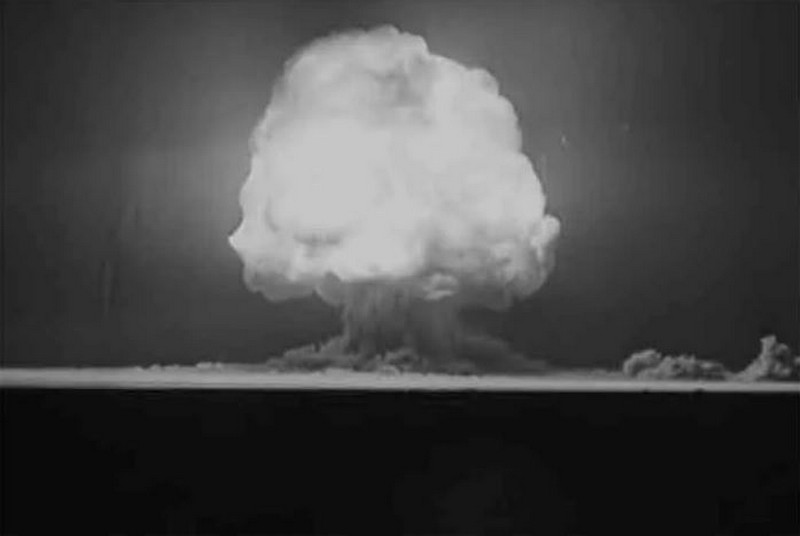By Lawrence S Wittner
This September is the sixtieth anniversary of U.S. and Soviet ratification of the world’s first significant nuclear arms control agreement, the Partial Test Ban Treaty. Thus, it’s an appropriate time to examine that treaty, as well as to consider what might be done to end the danger of nuclear annihilation.
Although the use, in 1945, of atomic bombs to destroy Hiroshima and Nagasaki unleashed a wave of public concern about human survival in the nuclear age, it declined with the emergence of the Cold War. But another, even larger wave developed during the 1950s and early 1960s as the nuclear arms race surged forward. At the time, the governments of the United States, the Soviet Union, and Britain engaged in testing a new nuclear device, the H-bomb, with a thousand times the power of the atomic bomb.
Many people found this situation alarming. Not only did the advent of H-bombs point toward universal doom in a future war, but the testing of the weapons sent vast clouds of radioactive “fallout” into the atmosphere, where it drifted around the planet until it descended upon the populace below. In 1957, Professor Linus Pauling, a Nobel Prize winner in chemistry, predicted that, thanks to the nuclear tests already conducted, a million people would die early, and 200,000 children would be born with serious mental deficiency or physical defects.
In reaction to this growing menace, millions of people around the world began to resist nuclear weapons. They formed new, activist organizations, including the National Committee for a Sane Nuclear Policy (better known as SANE) and Women Strike for Peace (in the United States), the Campaign for Nuclear Disarmament (in Britain, Canada, Australia, and New Zealand), the Japan Council Against A & H Bombs and the Japan Congress Against A & H Bombs (in Japan), and the Struggle Against Atomic Death (in West Germany). Even in the Soviet bloc, concerned scientists pressed for an end to the nuclear arms race.
Government officials in nuclear-armed nations, troubled by the rising agitation, as well as by opinion polls showing widespread popular distaste for nuclear testing, nuclear weapons, and nuclear war, gradually began to adapt their policies to the demands of the public. Meeting with top scientists in the U.S. nuclear weapons program, U.S. President Dwight Eisenhower told them that the U.S. government was “up against an extremely difficult world opinion situation” and that the country “could not permit itself to be ‘crucified on a cross of atoms.’” If U.S. nuclear testing continued, U.S. Secretary of State John Foster Dulles warned the president, “the slight military gains” would be “outweighed by the political losses.”
Accordingly, in 1958, the Soviet, American, and British governments halted nuclear testing while beginning negotiations for a test ban treaty. Failing to secure an agreement, they resumed nuclear tests in 1961, which led to nuclear testing remaining a very hot political issue for people and governments alike.
Into this controversy stepped Norman Cousins, the editor of a widely-read public affairs magazine, the Saturday Review, and, also, founder and co-chair of SANE. During a lengthy meeting at the White House with President John F. Kennedy in November 1962, Cousins inquired if the president would like him to meet with Soviet Premier Nikita Khrushchev to try to smooth the diplomatic path toward a nuclear test ban treaty. Kennedy responded affirmatively and, in the following months, Cousins shuttled back and forth between the two world leaders. Ultimately, Cousins overcame Khrushchev’s suspicions of Kennedy and, then, convinced Kennedy to deliver a major speech with “a breathtaking new approach” to Soviet-American relations.
This American University address, partially written by Cousins, proved an immediate success with Khrushchev. Test ban negotiations commenced in Moscow during July 1963, resulting in the Partial Test Ban Treaty―banning nuclear testing in the atmosphere, in outer space, and under water.
From the standpoint of ending the nuclear arms race, the treaty had its limitations. Because the treaty left unaddressed the issue of nuclear testing underground, the nuclear powers and aspiring nuclear powers simply shifted nuclear tests to this new locale. Furthermore, with nuclear fallout no longer a major public concern, popular pressure to halt nuclear testing―and, thereby, choke off the arms race―declined.
Nevertheless, the Partial Test Ban Treaty proved a turning point in world history. Together with the nuclear disarmament campaign that produced the treaty, it reduced Cold War hostility and ushered in a period of détente between the U.S. and Soviet governments. Furthermore, widespread nuclear proliferation, which seemed imminent at the time, failed to materialize. Even today, sixty years later, there are only nine nuclear powers.
Most important, the treaty demonstrated that nuclear arms control and disarmament were feasible. And so a host of treaties followed that substantially reduced nuclear dangers. These included the Nonproliferation Treaty, Strategic Arms Limitation Treaties, the Intermediate-Range Nuclear Forces Treaty, Strategic Arms Reduction Treaties, and the Comprehensive Test Ban Treaty. Through these treaties, as well as through unilateral action―both spurred on by popular pressure―the number of nuclear weapons in the world dropped sharply, from 70,000 to roughly 12,500. Meanwhile, nuclear war became increasingly unthinkable.
Of course, in recent years, with the decline of popular pressure against nuclear weapons, the prospect of nuclear annihilation has revived. Disarmament treaties have been scrapped, a new nuclear arms race has begun, and reckless leaders of nuclear nations have publicly threatened nuclear war. Although a UN Treaty on the Prohibition of Nuclear Weapons entered into force in 2021, the nine nuclear powers have resisted signing it.
Even so, as the Partial Test Ban Treaty and its successors show us, arms control and disarmament treaties have helped to curb the nuclear arms race and prevent nuclear war. Similarly, the revived march toward nuclear catastrophe can be halted by finally banning nuclear weapons―if people will demand it.
Lawrence S. Wittner (https://www.lawrenceswittner.com/ ) is Professor of History Emeritus at SUNY/Albany and the author of Confronting the Bomb (Stanford University Press).
4 September 2023
Source: countercurrents.org

